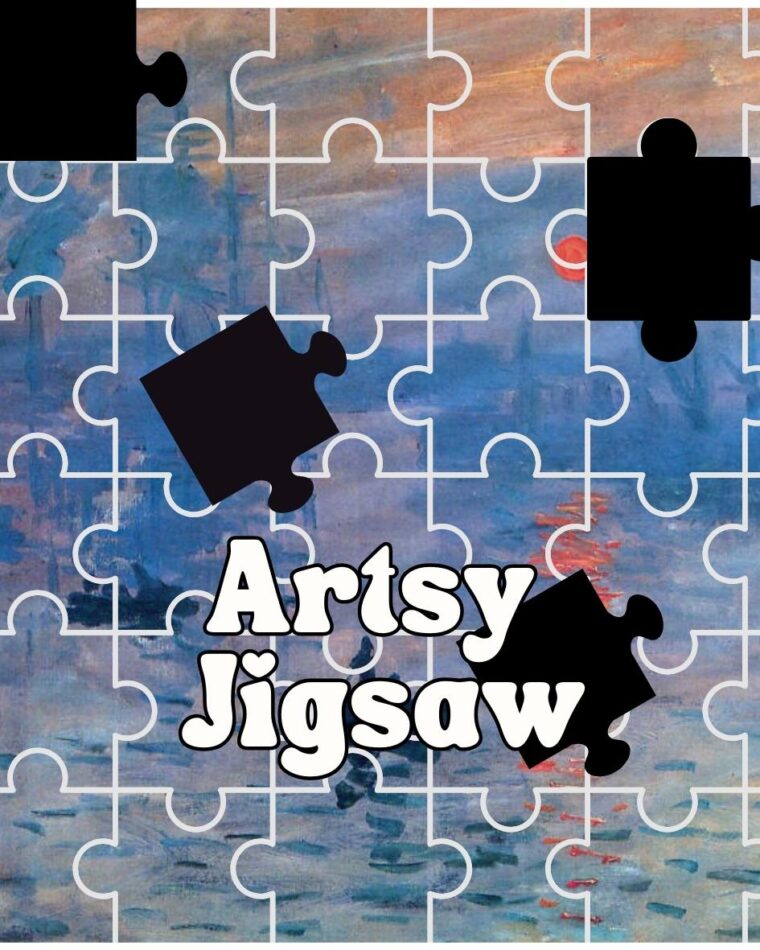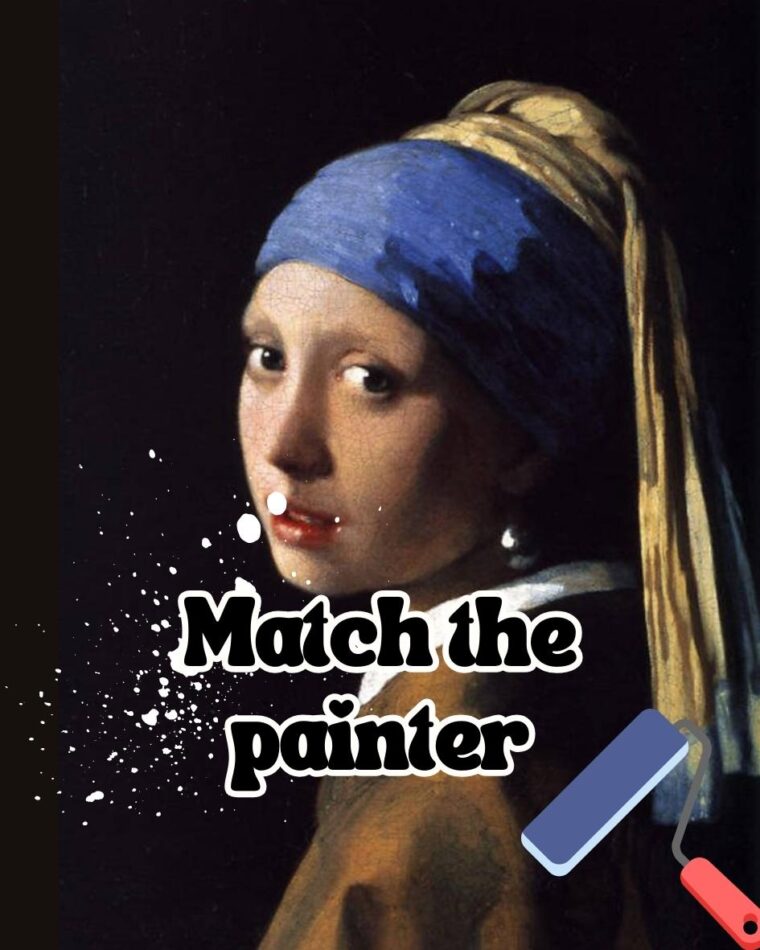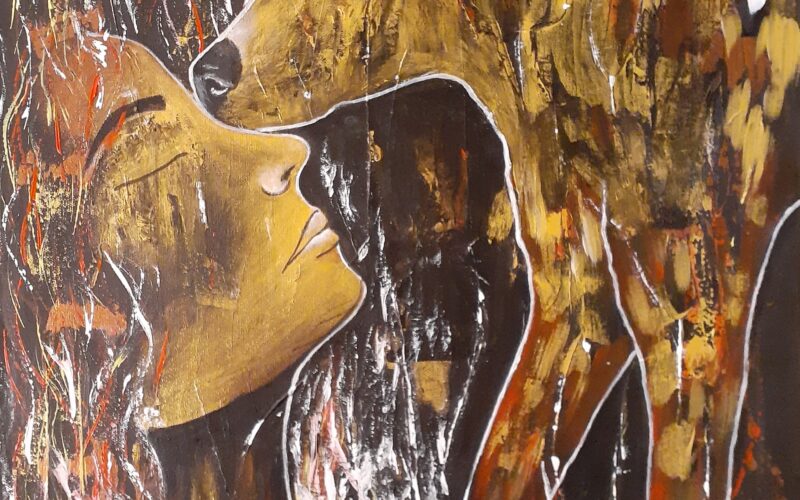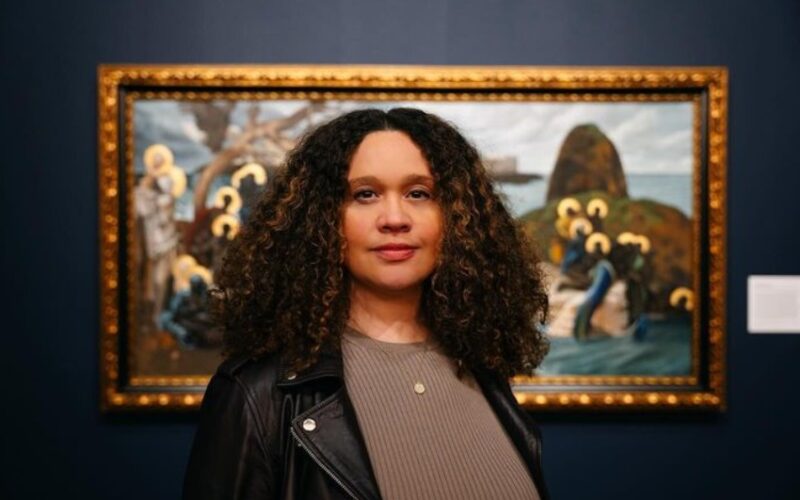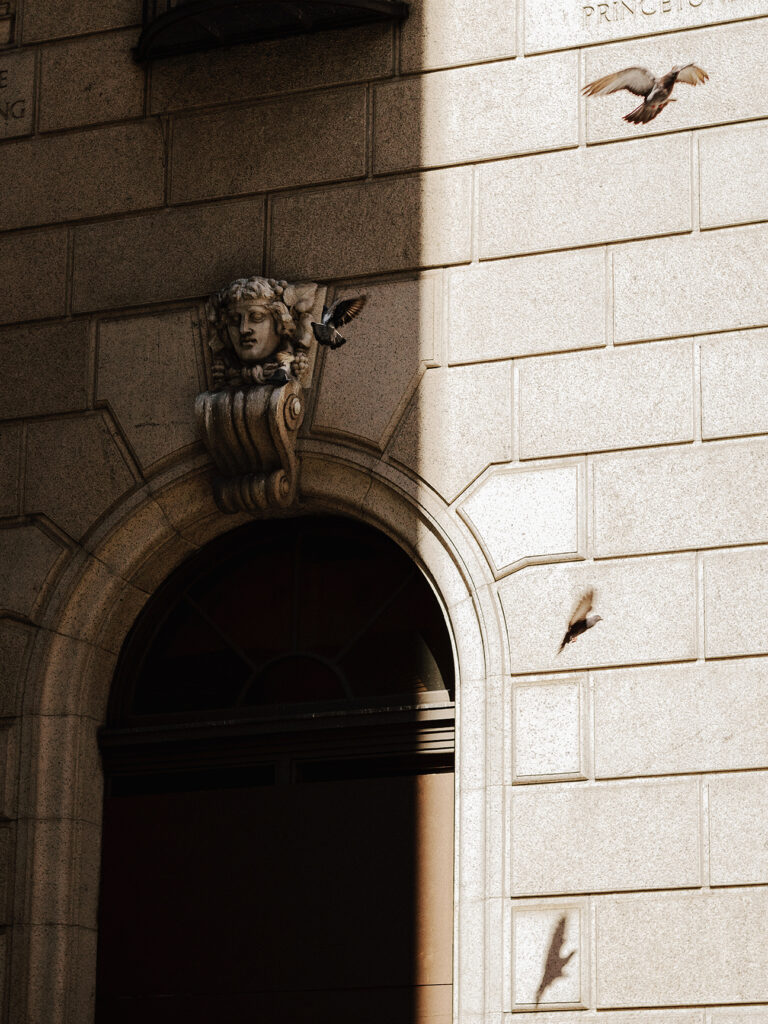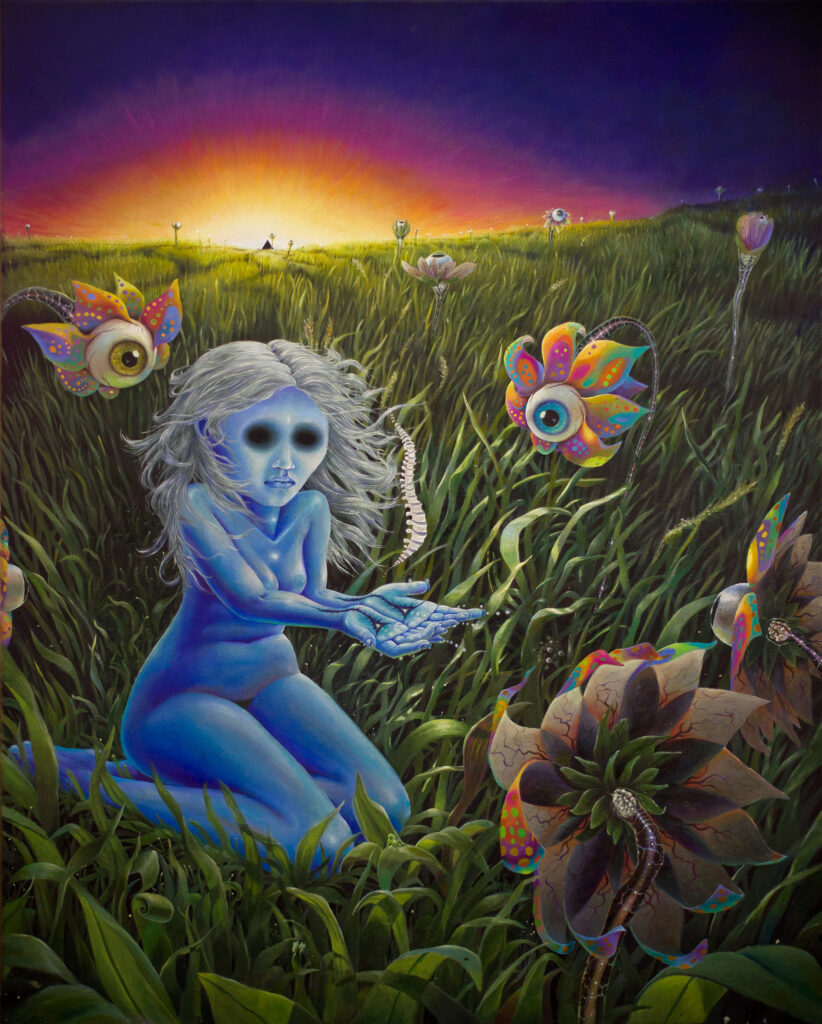
How Margaux McAllister’s Rug Tufted Masks Capture Emotional and Psychological Shifts
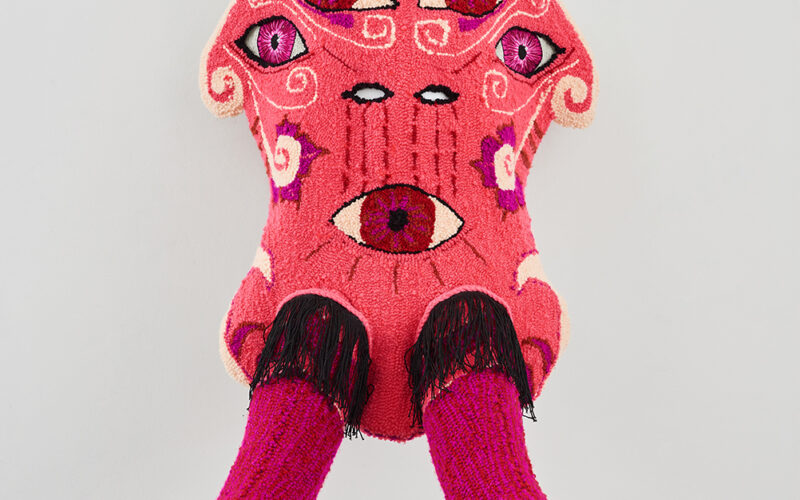

Margaux McAllister is a multidiciplinary artist from Phoenixville, Pennsylvania. She uses various techniques, such as rug tufting, embroidery, and painting, to explore her experiences as a mother and her emotional journey. In this interview, Margaux talks about how being a mom and dealing with mental health challenges influence her art. She also shares how she makes unique masks and balances her creative work with her family life. Margaux gives us a meaningful look into her transformation and the depth of human emotions through her art.
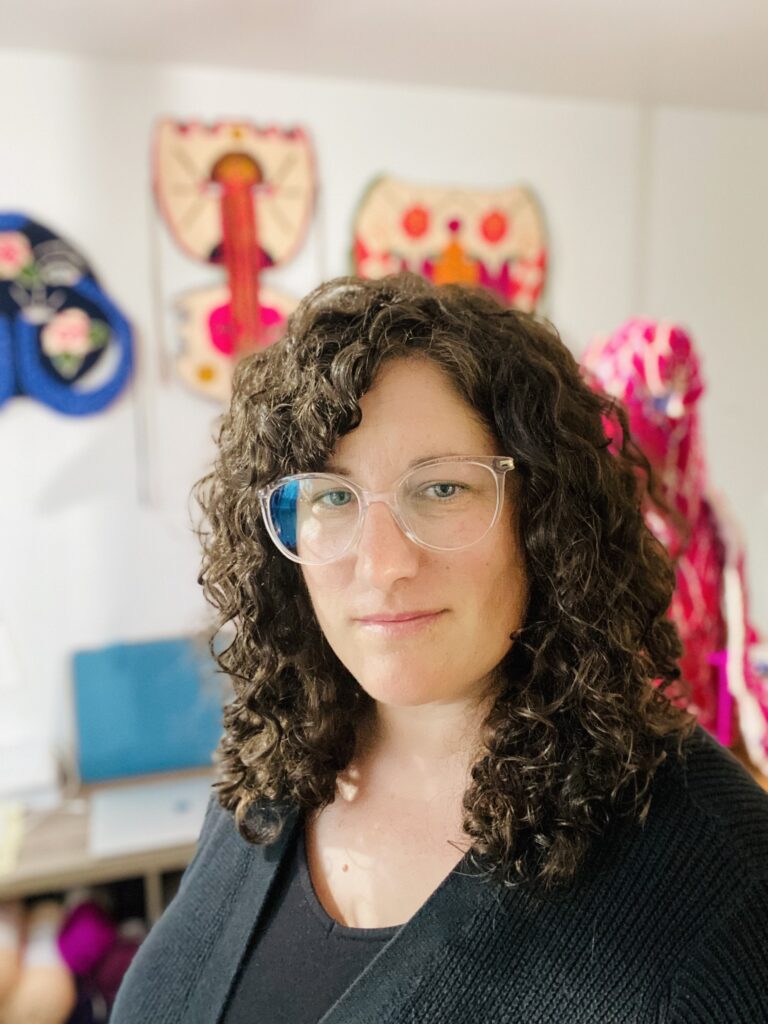
Margaux McAllister is a multidisciplinary artist who received her MFA from the San Francisco Art Institute and her BFA from Moore College of Art and Design. Currently living and working in Phoenixville, Pennsylvania, her work explores identity, specifically as a mother. She aims for her work to record this psychological and emotional journey. She explores how emotions define and challenge our identities using rug tufting, embroidery, beading, and painting.
Margaux McAllister, a multidisciplinary artist, explores themes like identity, motherhood, and psychological states of being. She believes that self-reflection can lead to transformation and that imagination serves as the catalyst for this exploration. Using the figure as her subject, she expresses how her psychological makeup influences the self, familial relationships, and environments. Nature, she notes, serves as a symbol of emotions and meaning and a tool for teaching patience. She grows many of the flowers and plants referenced in her work, considering the growing process a part of her art practice.
As both an artist and a mother, she creates masks to express emotional states and challenge and define identities. These masks are seen as physical manifestations of feelings, experiences, or evidence of healing from her daily experiences. Through mask-making, she delves into the complexities of motherhood, familial relationships, mental health, and healing. The inherent dichotomy of a mask allows the wearer to hide and reveal parts of themselves simultaneously. By using rug tufting for the masks, she subverts the domestic qualities of the medium. Her paintings, she suggests, act as performances of her fiber sculptures. Her changing identity as a woman and mother is reflected in her art, which aims to document her psychological and emotional journey.
1. Margaux, how do themes like identity, motherhood, and psychological states shape your creative process and the pieces you create?
My creative process directly relates to how I process the world and what I am experiencing. As a mother and a person with mental health challenges such as bipolar II, depression, and anxiety, I use art as a form of therapy to help me understand my emotions and reactions to everyday circumstances and challenges. The pieces I create often analyze why I feel a certain way or examine a relationship, such as my relationship with my children. Motherhood has changed my identity, and I use my art to reflect that transformation and examine identity’s multifaceted nature.
As a mother and a person with mental health challenges such as bipolar II, depression, and anxiety, I use art as a form of therapy to help me understand my emotions and reactions to everyday circumstances and challenges.
Margaux McAllister
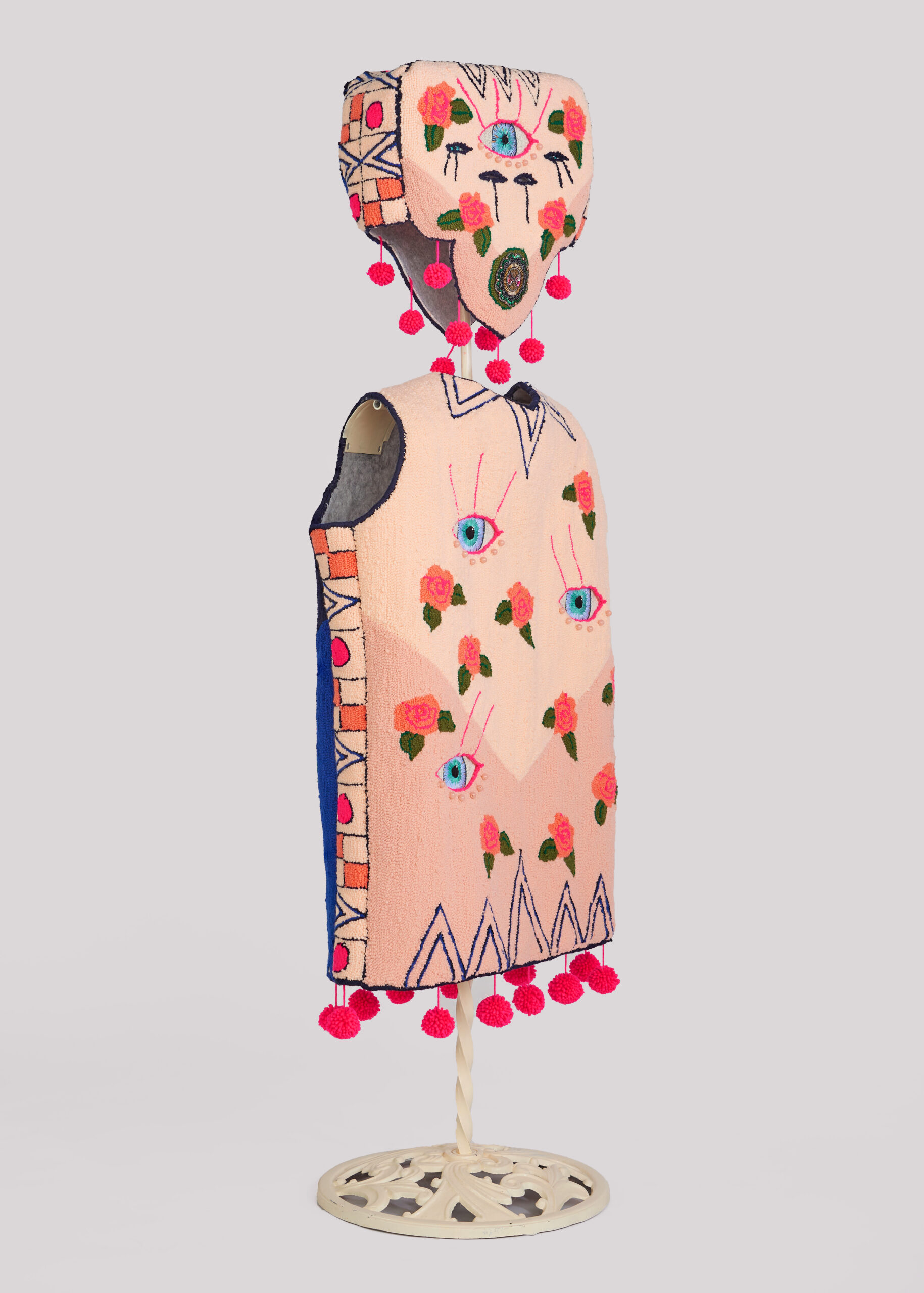
2. You mention that imagination is a catalyst for self-reflection and transformation. Can you share a specific moment or experience where this played a crucial role in your art?
My piece “Your Past Is Always Present II” examines how self-reflection can promote transformation. This wearable costume consists of a body suit and a headpiece made of tufted yarn, embroidery floss, and beads. The head and suit have large embroidered eyes on the front and back. The eyes on the back are looking towards the past, shedding judgment and learning to create a new self-image. The eyes on the front are open wide, looking towards the future. Wearing the piece provides the wearer the opportunity to be in the present with the teachings of the past and the hope for the future in balance. This piece is about resolving past issues through self-nurturing and allowing oneself to carry those lessons into the present with open eyes for the future.
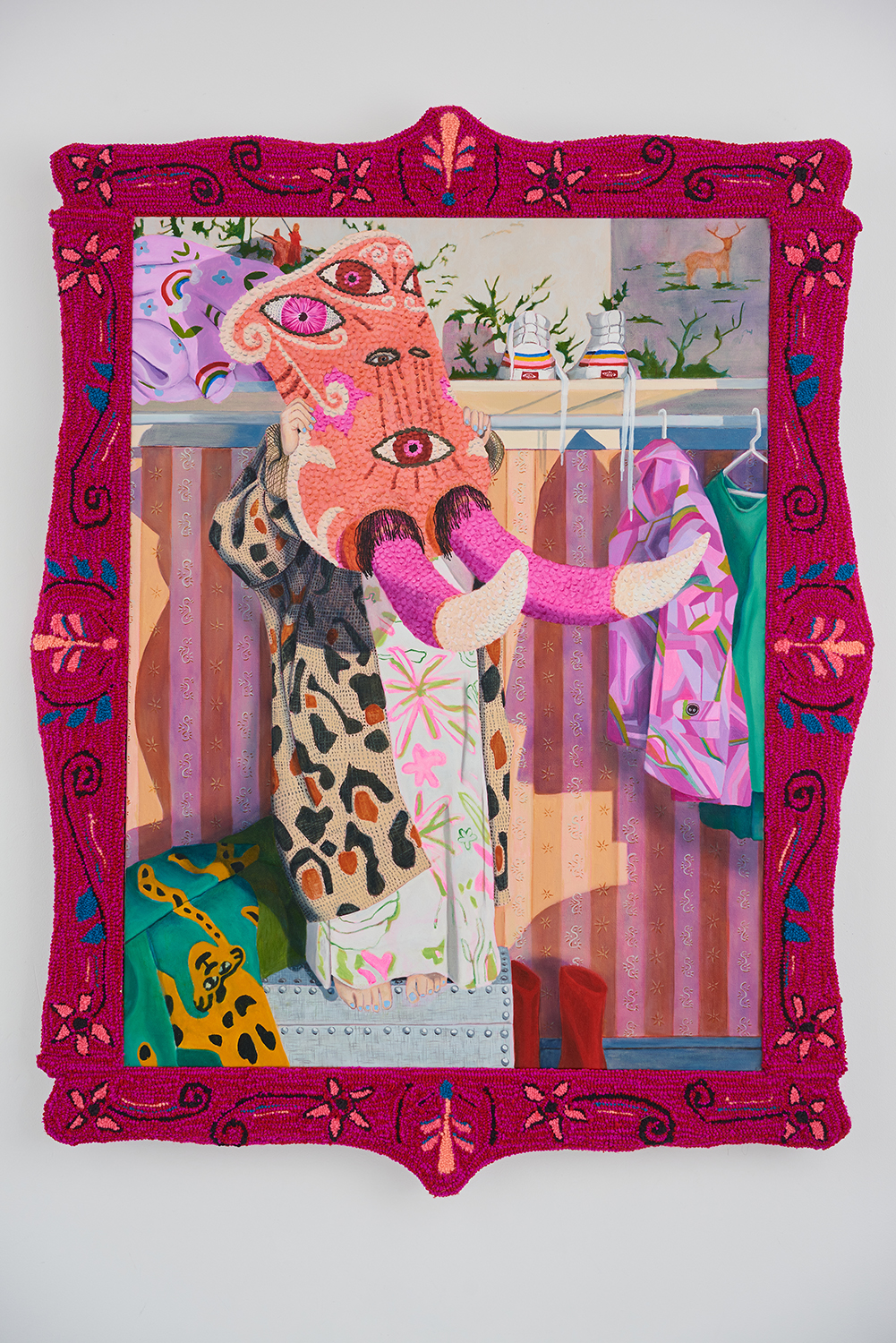
3. The masks you create are physical manifestations of your feelings. Can you tell us more about the process of making these masks and the emotions they represent?
Using a rug tufting gun, I create wearable masks representing different emotions or states of being. To develop these masks, I first sketched the general shapes and patterns I wanted to use. Rug tufting is a textile that uses a handheld machine to push yarn through a fabric substrate stretched tightly over a wooden frame. This process is called tufting. Depending on the emotion I am representing, I choose a pallet that reflects the feeling. For instance, I may select warm, highly saturated, intense colors if I am trying to express anger or frustration. I then define the shape and patterns on the masks by creating paper templates that I cut out and use to trace onto the stretched fabric. Next, I tuft the mask, and to secure the yarn to the fabric, I use a latex medium over the backside of the tufted piece. This is basically a glue that keeps the yarn in place. Next, I cut the mask from the fabric and finished the edges by gluing them to the back of the piece, creating a clean edge. Some of the masks have embroidered elements such as eyes and beaded embellishments. The emotions I represent in the masks come from my daily experiences as a human and mother. I often look to my intuition to decide on patterns and colors and am inspired by vintage textiles, found objects, and nature.
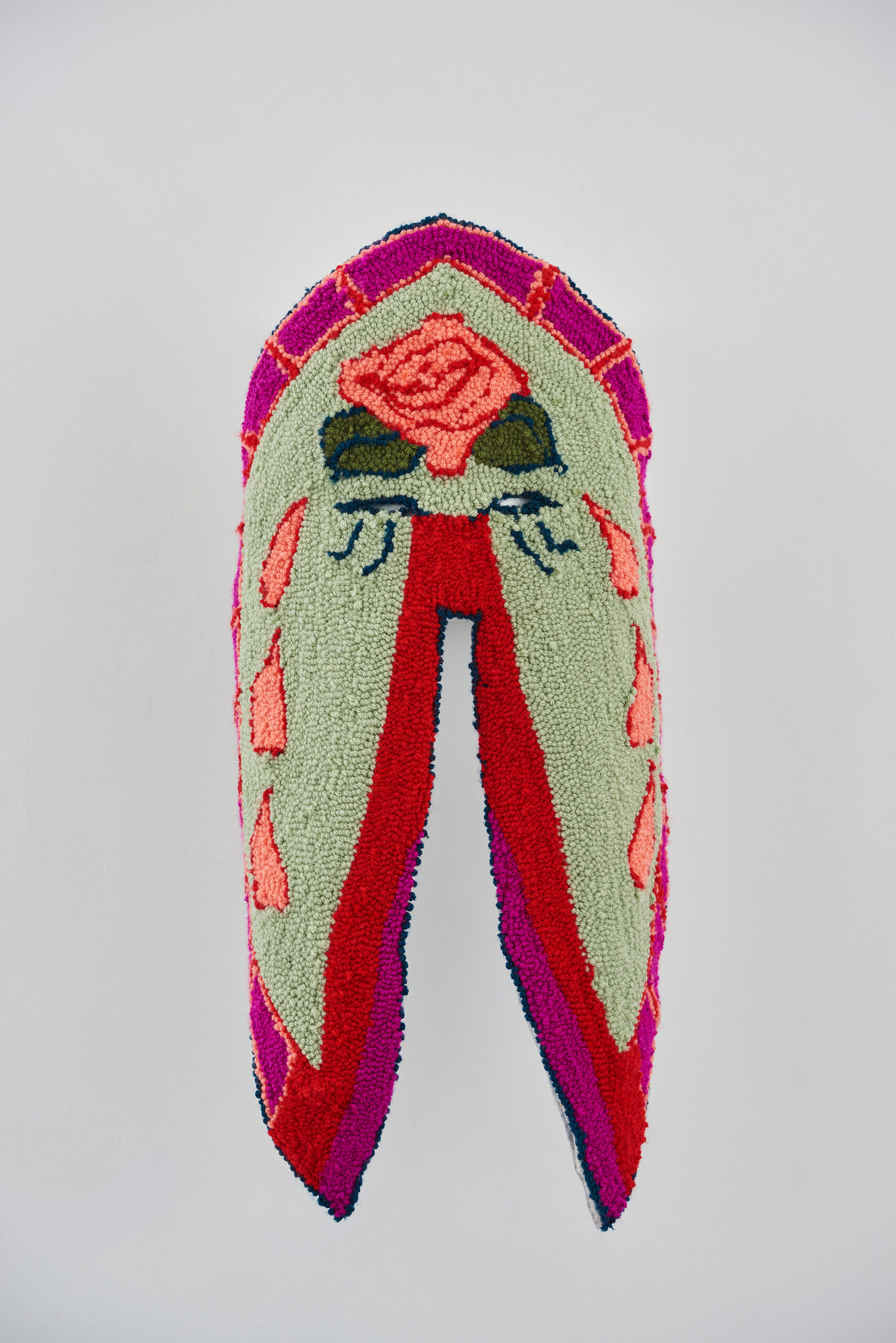
4. how do you balance your personal and professional life as an artist and mother?
Being an artist mother is a challenge when it comes to time. I have two young children, ages 9 and 6. I have to prioritize my studio time to get work made. I have found that creating in fibers has allowed me to work on artwork while still being available to my children throughout the day. I can easily stop and start embroidery or tufting to tend to their needs. I basically sneak in time in the studio whenever I can. When the kids are in school full-time, I can treat that time as studio time. When they get on the bus in the morning for school, I clock into the studio for the day until their return. If I am working on a painting, it is a little more difficult to be interrupted, so I paint at night or when the kids are at school.
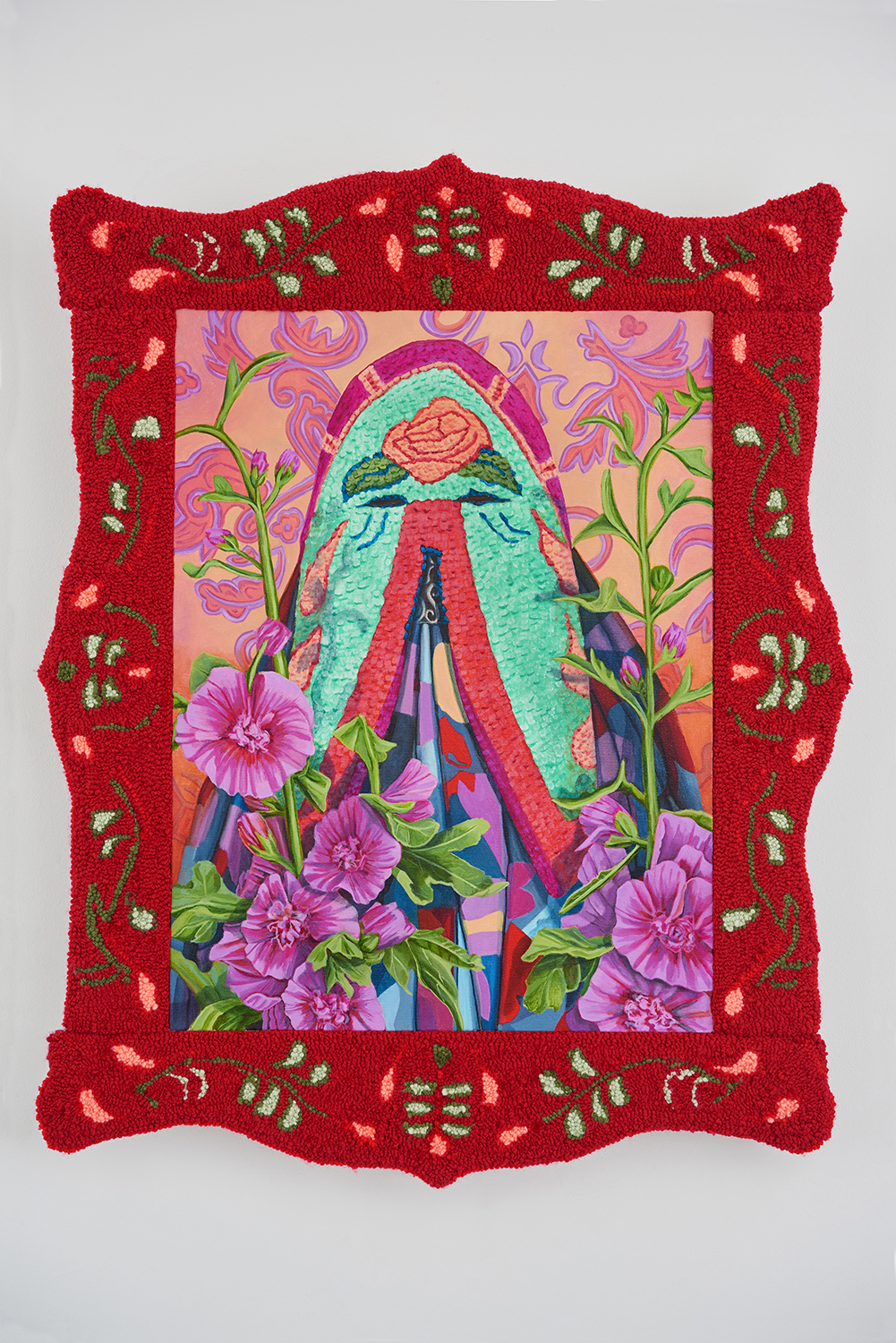
5. You’ve had many exhibitions and publications throughout your career. What has been one of your most meaningful exhibitions or moments, and why?
One of the most meaningful exhibitions for me was my exhibition this summer at Philadelphia’s Magic Gardens, curated by Chelsey Luster. The exhibition was called “Threads of Transformation,” a two-person show that included work from Krista Dedrick-lai. This exhibition was an opportunity for me to show work that I had never shown before, and it was a culmination of years of work coming together in one show. I could show paintings, photographs, sculptures, and fireworks together in one space. This exhibition was an honor to be a part of; it validated me and my work on a level I hadn’t had before.
6. What is one piece of advice you would give to aspiring artists?
I would say to aspiring artists: Make the work for yourself and stay disciplined. Put in the hours and long days in the studio. Allow yourself to make mistakes and learn from them. Don’t neglect the importance of having life experiences. From those experiences and mistakes comes inspiration, content, and the guts of the work. Make a point to take risks. If something feels uncomfortable, explore it more.
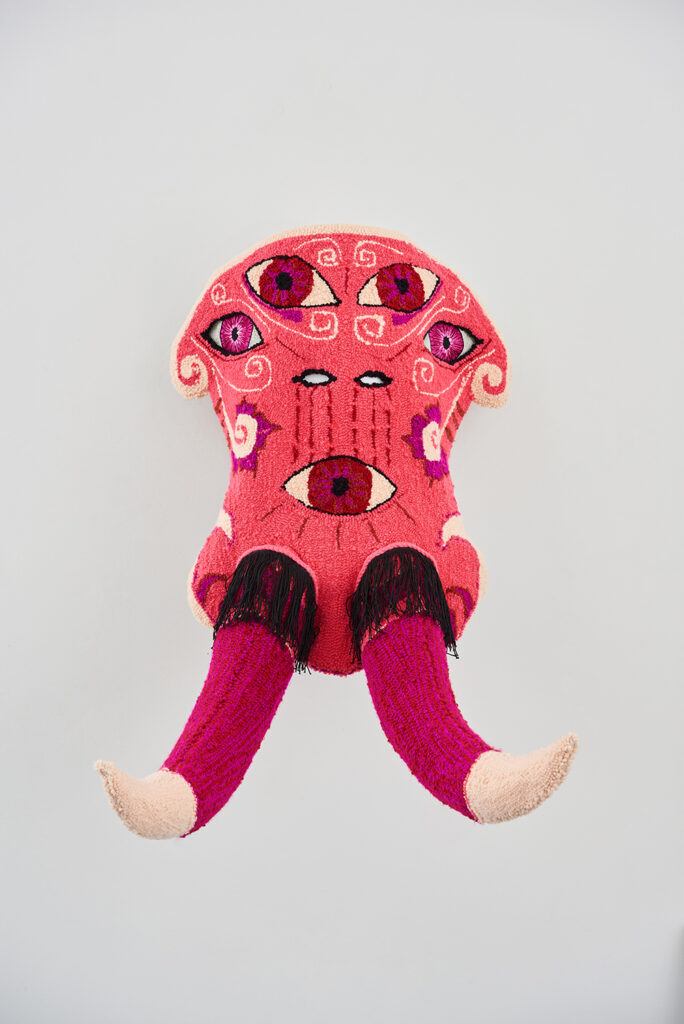
Don’t neglect the importance of having life experiences. From those experiences and mistakes comes inspiration, content, and the guts of the work. Make a point to take risks. If something feels uncomfortable, explore it more.
Margaux McAllister
Margaux McAllister’s art is a powerful example of how creativity can help us understand and express ourselves. Her work, which combines different art techniques, reflects her experiences with identity and motherhood. The masks she creates are more than just art; they represent the emotions and growth she’s gone through. Balancing her roles as an artist and a mom, Margaux’s journey shows us how art can be a deeply personal and transformative experience. To learn more about Margaux, click the following links to visit her profile.





